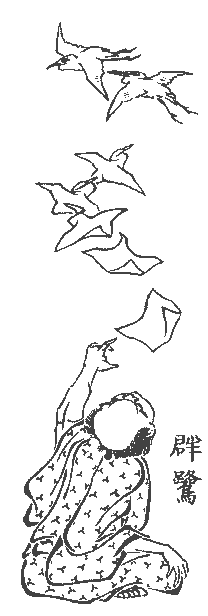




A Brief History of Origami
Origami is a Japanese word derived from the terms 'oru, to fold' and 'kami, paper'. It is now practiced all over the world in many different forms. On this page, I will attempt briefly to describe the history of the art of paperfolding.Papermaking is thought to have originated from China and spread to Japan by the 6th Century AD. Simple models such as Noshi, a type of charm for warriors and nobles were folded although paper was expensive. Folding was gradually incorporated into many aspects of day-to-day like, including religion. Models were not diagrammed but were taught from one generation to the next.

|
By the 18th Century, the first sets of diagrams were generating, including the Senbazuru Orikata, or how to fold 1000 cranes. Designs at this stage in history were simple and often involved cuts and gluing. The modern era of paper folding owes much to Akira Yoshizawa, who has created thousands of models, many of them 3-D and far more complex than earlier models. He also established the practice of wet-folding. Yoshizawa also made the art internationally popular, attracting folders such as Robert Harbin, who later founded the British Origami Society. For a more detailed history, Joseph Wu's website has an excellent essay suitable for most school projects. Another superb history appears in the book 'Origami, From Angelfish to Zen, by Peter Engle'. Not only is this an interesting read, it gives a great series of essays on the philosophy behind folding! For the most informative esay to date, including cross referencing and authorative sources, John Smith has written the best presentation so far. From Japan to Spain, from daVinci to Lewis Carroll, this contains almost everything anyone could want to know! |